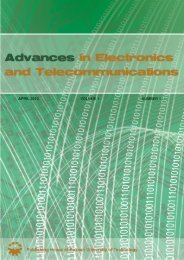november 2010 volume 1 number 2 - Advances in Electronics and ...
november 2010 volume 1 number 2 - Advances in Electronics and ...
november 2010 volume 1 number 2 - Advances in Electronics and ...
You also want an ePaper? Increase the reach of your titles
YUMPU automatically turns print PDFs into web optimized ePapers that Google loves.
28 ADVANCES IN ELECTRONICS AND TELECOMMUNICATIONS, VOL. 1, NO. 2, NOVEMBER <strong>2010</strong><br />
Fig. 2. Topology of simulated network.<br />
Fig. 3. Throughput of CBR the transmission as a function of N.<br />
over classic TFRC (with TCP throughput equation) causes<br />
strong degradation of a CBR connection <strong>in</strong> the case of larger<br />
values of N.<br />
The usage of the proposed solution <strong>in</strong>stead of classic<br />
TFRC allows one to achieve throughput of the CBR stream<br />
comparableto thethroughputof CBR overRTP. Moreover,the<br />
parameters of TCP transmissions are approximately the same<br />
as those observed when classic TFRC is used. It means that<br />
the l<strong>in</strong>ear equation avoids the collapse of the TCP connections<br />
<strong>and</strong> allows the TCP to utilize available b<strong>and</strong>width (b<strong>and</strong>width<br />
of the bottleneck l<strong>in</strong>k reduced by target bit rate of multimedia<br />
stream).<br />
In the second experiment we changed the throughput of the<br />
CBR transmission B from 0.5 Mb/s to 4 Mb/s (throughput of<br />
the bottleneckl<strong>in</strong>k). The <strong>number</strong> of compet<strong>in</strong>gTCP flows was<br />
set to 1. Results of experiments are shown <strong>in</strong> Fig. 4.<br />
As we can see <strong>in</strong> Fig. 4, TFRC with the l<strong>in</strong>ear equation<br />
allows one to transmit real-time multimedia even if the target<br />
bit rate of the CBR stream is close to the throughput of<br />
bottleneckl<strong>in</strong>k.BothRTP<strong>and</strong>classicTFRCwereabletocarry<br />
out real-time transmission up to about a half of the throughput<br />
of the bottleneck l<strong>in</strong>k (at least <strong>in</strong> this experiment). In the case<br />
of both modified TFRC <strong>and</strong> classic TFRC, concurrent TCP<br />
streams were able to utilize all rema<strong>in</strong><strong>in</strong>g b<strong>and</strong>width of the<br />
bottleneck l<strong>in</strong>k.<br />
Fig. 4. Throughput of CBR transmission as a function of B.<br />
VI. CONCLUSION<br />
Although the authors of TFRC suggest that the protocol<br />
is suitable for multimedia transmission, it is not aggressive<br />
enough to meet the QoS requirements of carried stream<strong>in</strong>g<br />
media when it competes for b<strong>and</strong>width with the TCP. In the<br />
paper we propose to substitute the orig<strong>in</strong>al TFRC throughput<br />
equation with a l<strong>in</strong>ear throughput equation. This substitution<br />
makes the TFRC more aggressive, which allows the protocol<br />
to preserve the real-time character of the transmitted flow<br />
no worse than the RTP or the UDP protocol. Moreover, <strong>in</strong><br />
situations when the usage of the RTP causes the collapse of<br />
TCP transmission (or, at least, worsen<strong>in</strong>gof the QoS of one or<br />
more TCP flows), the proposed solution is “friendly” enough<br />
for compet<strong>in</strong>g TCP flows to equally share the rema<strong>in</strong><strong>in</strong>g<br />
b<strong>and</strong>width. Such results allow us to believe that the proposed<br />
l<strong>in</strong>ear equation is more suitable for multimedia transmission<br />
than the equation orig<strong>in</strong>ally <strong>in</strong>cluded <strong>in</strong> the RFC 3448.<br />
REFERENCES<br />
[1] M. H<strong>and</strong>ley, S. F. J. Padhye, <strong>and</strong> J. Widmer, TCP Friendly Rate Control<br />
(TFRC): Protocol Specification, IETF RFC 3448, Jan. 2003.<br />
[2] J. P. S. Floyd, M. H<strong>and</strong>ley <strong>and</strong> J. Widmer, TCP Friendly Rate Control<br />
(TFRC): Protocol Specification, IETF RFC 5348, Sep. 2008.<br />
[3] A. Chodorek <strong>and</strong> R. R. Chodorek, “Applicability of TCP-friendly protocols<br />
for real-time multimedia transmission,” <strong>in</strong> Proc. XII Poznan Telecommunications<br />
Workshop (PWT), Poznan, 2007.<br />
[4] A. Chodorek, “Stream<strong>in</strong>g video with TFRC - simulation approach,” <strong>in</strong><br />
Proc. of SympoTIC’04, Oct. 2004.<br />
[5] A. Chodorek, R. R. Chodorek, <strong>and</strong> A. R. Pach, Dystrybucja danych w<br />
sieci Internet. Warszawa: WKŁ, 2007.<br />
[6] J. Padhye, “Model-based approach to TCP-friendly congestion control,”<br />
Ph.D. dissertation, Department of Computer Science, University of Massachusetts<br />
at Amherst, 2000.<br />
[7] J.Padhye, V. Firoiu, D.Towsley, <strong>and</strong> J.Kurose, “Model<strong>in</strong>g TCPThroughput:<br />
A Simple Model <strong>and</strong> its Empirical Validation,” <strong>in</strong> Proc. Proceed<strong>in</strong>gs<br />
of ACM SIGCOMM, 1998.<br />
[8] H. Schulzr<strong>in</strong>ne, S. Casner, R. Frederick, <strong>and</strong> V. Jacobson, RTP: A<br />
Transport Protocol for Real-Time Applications, IETF RFC 3550, Jul.<br />
2003.<br />
Agnieszka Chodorek received her M.Sc. degree <strong>in</strong> electrical eng<strong>in</strong>eer<strong>in</strong>g<br />
from the Kielce University of Technology <strong>in</strong> Kielce, Pol<strong>and</strong>, <strong>in</strong> 1991, <strong>and</strong><br />
her Ph.D. degree <strong>in</strong> telecommunications from the AGH University of Science<br />
<strong>and</strong> Technology <strong>in</strong> Krakow, Pol<strong>and</strong>, <strong>in</strong> 2001. She is an assistant professor<br />
at the Department of Telecommunications, Photonics <strong>and</strong> Nanomaterials,<br />
Kielce University of Technology <strong>in</strong> Kielce, Pol<strong>and</strong>. She is currently lectur<strong>in</strong>g







